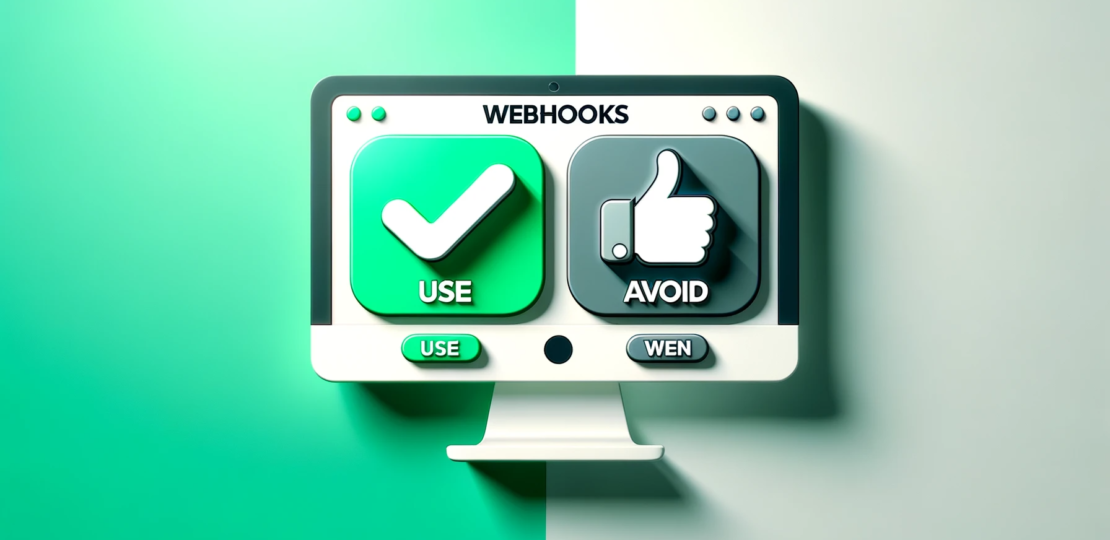
When to use
Webhooks are best used in situations where you want real-time communication between different services without constantly polling for updates. Here are some scenarios where using webhooks would be beneficial:
1. Real-Time Notifications
Explanation: If your application relies on real-time updates, webhooks are an excellent choice for enabling instant notifications.
Example: A chat application notifying users when they receive a new message.
2. Third-Party Integrations
Explanation: For services like payment gateways, CRM, and other SaaS products, webhooks can notify your system of events that happen in the external service.
Example: Notifying your system when a new payment is made via Stripe.
3. Event-Driven Architecture
Explanation: If your system is based on events, webhooks can help in publishing these events to subscribers immediately.
Example: Inventory management systems alerting when stock goes below a certain level.
4. Decoupling Systems
Explanation: Webhooks help in creating loosely-coupled architectures where systems can communicate without knowing much about each other.
Example: Microservices architecture where services are isolated but need to communicate.
5. Extensibility
Explanation: If you want to allow third-party developers to extend your platform, webhooks are a way to allow them to hook into events.
Example: GitHub allows developers to use webhooks to integrate with their CI/CD pipelines.
6. Reducing Server Load
Explanation: Traditional polling methods place a continuous load on the server. Webhooks eliminate this by pushing events only when necessary.
Example: Instead of polling an email service for new messages, a webhook notifies you when a new email arrives.
7. Streamlining Workflows
Explanation: Webhooks can trigger a series of actions automatically, making workflows more efficient.
Example: Automatically creating a support ticket when a user submits a feedback form.
8. Compliance and Monitoring
Explanation: Webhooks can notify you of important events that require immediate action, which can be essential for compliance and monitoring.
Example: Alerting the security team if a data breach is detected.
9. Multi-Platform Synchronization
Explanation: If you have a service that runs across multiple platforms (web, mobile, IoT, etc.), webhooks can help keep data in sync across these platforms.
Example: Updating user settings across web and mobile applications.
10. Distributed Systems
Explanation: In a distributed architecture, webhooks can help in replicating data or events across different parts of the system.
Example: Updating multiple cache servers when the original data changes.
In summary, if your use-case involves real-time notifications, third-party integrations, event-driven architectures, or any form of asynchronous communication between different parts of your system, webhooks are likely a good fit. However, they do introduce complexity in terms of error-handling, security, and idempotency, which need to be carefully managed.
When not to use
Webhooks are powerful, but they are not always the best choice for every scenario. Here are some situations where you might consider alternatives to webhooks:
1. Sensitive Information Transfer
Explanation: Webhooks usually transmit data over HTTP, and even though HTTPS is secure, it may not meet strict compliance regulations for ultra-sensitive data.
Example: Medical records in healthcare applications.
2. High-Frequency Events
Explanation: If events are being triggered too frequently, the receiving endpoint may become overwhelmed, and rate limiting could kick in.
Example: Real-time stock price updates that occur multiple times per second.
3. Lack of Error-Handling Mechanisms
Explanation: If you don’t have the infrastructure to handle retries, logging, and alerting, webhooks may add complexity and potential points of failure.
Example: Small projects without robust operational monitoring.
4. Sequential Processing Requirements
Explanation: Webhooks are generally designed for asynchronous processing. If you have requirements for synchronous, sequential event handling, webhooks may not be ideal.
Example: Transactional operations in a banking system that need to occur in a specific order.
5. Polling is More Appropriate
Explanation: Some situations might require you to have the most current state of the data, where polling could be more straightforward.
Example: Getting the current status of a single, rarely-updated resource.
6. No Control Over Subscriber
Explanation: If you have no control over the subscriber’s system, you risk data being lost or not processed in time.
Example: Third-party services that do not guarantee processing of incoming webhooks.
7. Tight Coupling
Explanation: If the services are tightly coupled and part of the same system or monolith, direct function/method calls may be more appropriate.
Example: Inter-module communication within the same software package.
8. Need for Two-Way Communication
Explanation: Webhooks are unidirectional. If you need a two-way real-time channel, you might want to consider WebSockets or similar technologies.
Example: A real-time multiplayer game where players’ actions affect each other instantaneously.
9. Limited Resources
Explanation: If your server has limited resources, handling incoming webhooks might not be optimal.
Example: Budget hosting plans with limited CPU and memory.
10. Data Consistency
Explanation: If you require strong data consistency and ACID properties, webhooks’ asynchronous nature might not be suitable.
Example: Financial systems requiring immediate consistency across multiple databases.
When considering whether to use webhooks, always assess the specific needs of your application, including your resources, the nature of the data you’re dealing with, and the kind of interactions you need to support. If any of the above points resonate with your scenario, you may want to explore alternative methods for achieving your goals.
RELATED POSTS
View all


